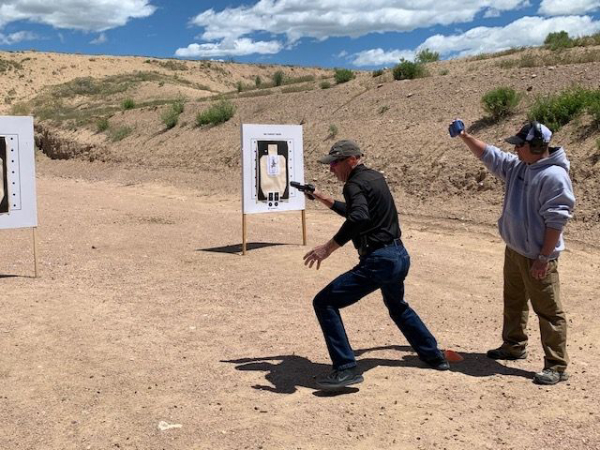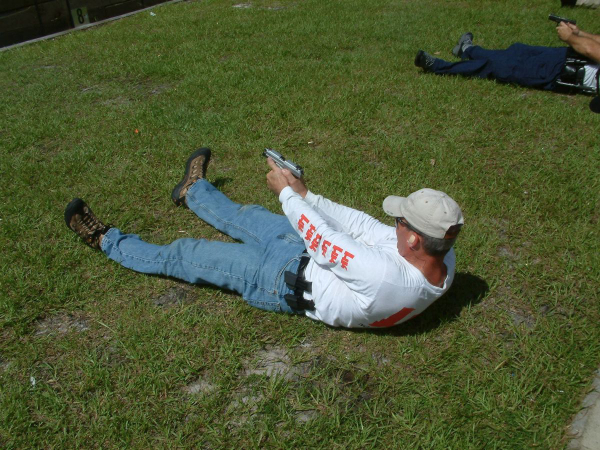Today’s feature is from correspondent Dave Spaulding.
I was criticized regularly, while running my training company, for “turning your back on a threat.” People deliver these criticisms with limited information, which is ill-advised. This criticism is uncalled for, as I am not telling students of the combative pistol to turn their backs on threats. I am telling them not to run backwards. There is a big difference.
It has been a tradition for as long as I can remember to simulate staying on a threat (target) as it “goes down” and then holding for an undetermined period of time to make sure it “stays down”. I get it, but I’m not sure what this accomplishes as the paper target does not fall. There is no visual indication of a threat and whether it is incapacitated or will get back up. Students are merely “imaging” a threat and hopefully are holding long enough since there is really no way to know for sure. It’s like the simulated scan; one does it but no one really knows what is being. Most shooters turn their heads way too fast to truly see, but it does look cool.
Why do we do this? Tradition mostly…
I have long asked people who emphasize this hold on target what happens if the “threat’s” friends do not allow them to hold on target for the desired amount of time? You know, they attack from the flank before you are ready to look for other threats? This is reality, you know. I usually get a frozen stare as they try to process this. After all, this is not part of tradition, it’s not what they normally do. When I suggest they may want to look around as soon as they get some feedback from their original threat (like folding over or falling down, something a fixed target does not do) I usually hear “they may get back up!” True, but how long does a look around for other attackers take? After all, you are not looking to scan the area hard at this point. You are looking for obvious threats like someone running at you, stabbing with a knife or pointing a gun. Yeah, not perfect but gunfighting seldom is.

Turning away from a threat and moving quickly is another subject that gets emotional on the Internet. It’s easy to “type a good gunfight” from the comfort of your computer and much harder to actually do it under the duress of someone trying to kill you. The fact of the matter is you can’t run backwards. By run I mean move quickly, at a speed that will help save your life if bullets are in bound. Yes, it is possible to move to the rear at a controlled speed, but if moving as fast as humanly possible to create distance is the goal, then trying to move quickly backwards will result in a fall and falling in a gunfight can prove fatal.
Moving to the rear in a controlled fashion can be accomplished two ways. The first is a “step and drag” technique that has the shooter step back with one foot and then drag the trailing foot into place. The second is a “shuffle step” in which the feet are kept in contact with the ground and shifted back and forth…neither will allow for the development of the type of speed needed to get from place to place as fast as humanly possible.
If you take a moment to think about how you move forward you will note the body’s center of gravity (the hips) stays either above or in between the feet while moving. As you step and move forward, the hips are between the feet and as forward progression continues, the hips move over top of the feet until they are centered again between them. This is a very efficient method and it allows us to walk, jog, run and sprint without falling. In addition, our eyes are in front of our head -- the same way our feet are pointed. Our arms move forward and back as we accelerate. Even when moving laterally, the body keeps the hips either over or between the feet. Falling occurs when the feet stop but the hips do not due to momentum -- and you topple over.

Moving rapidly to the rear does not allow for this natural shift of the center of gravity between the feet. The shuffle step and step and drag work to accomplish this, but when speed becomes the overriding concern, the hips shift forward of the feet as the body moves to the rear. Since the feet and toes are not pointed in the direction of said movement, the ass overrides the feet and the combatant falls. If you don’t believe me, watch Live Leak or You Tube and you will find a number of gunfight videos, primarily officer involved shootings, in which shooters try to move backwards rapidly and fall on flat surfaces.
During rapid rearward movement, the typical person will have 3 to 4 steps before they run the risk of falling. This means a rapid disengagement, such as pushing away from a close contact fight, is possible but continued rearward movement becomes perilous. At this point, the combatant has two choices: 1. Stay facing the threat and move controlled but slowly back, or 2. Turn and move rapidly away. Which you choose will be based on the situation you face. Yes, it will be situationally dependent, a reality of combat. No two fights are exactly alike and it is impossible to train for every potential situation one may face. Thus, you focus and practice skill sets and change as necessary.
The idea that you will NEVER turn away from a threat is ludicrous! If confronted by a group of thugs on a street, do you back away slowly or turn and run? You might be able to fight them off if they use Hollywood rules and attack you one at a time, but probably not.
If moving quickly is more important than moving in a controlled fashion, you may have to turn your back in order to create distance, move to cover or gain a position of advantage to continue the fight. If you have someone to cover you that is fantastic! A “leap frog” movement will ensue with verbalization to ensure covered rearward movement. If not, move fast, turn as necessary and move again. The choice is up to you and will be based on what you perceive to be IMPORTANT NOW, at this moment in time. One thing I have learned over four decades of law enforcement and firearms training is to avoid the use of the words NEVER and ALWAYS: one or the other will certainly bite you in the ass at some point.
Finally, consider falling on your back in the middle of a gunfight. As you fall backwards, there is a good chance you will roll back and your ass will rise due to momentum (unless you have been trained in how to fall). I have had several medical experts tell me if you take a round through the rectum that travels a long way up through the torso, there is a good chance it will result in a NON-SURVIVABLE WOUND. As a bullet travels a long way (most gunshot wounds travel across the body), a considerable amount of damage to a wide variety of organs and the spine can occur. Infection would certainly be a concern. In this age of medical care, your chances would be better than ever before, but those who work in the field tell me it would be a very tough fight.
In the end, it comes down to what’s important now while the fight ensues. In truth, there is no way to predict how the fight will unfold but to say you will never do something is fraught with peril. Yep, you may have to turn away from a threat to fight another or move quickly to a better position but one thing I can say with great certainty: you will not be able to run backwards FAST.
The choice is yours of course. Believe and do what you see as being best.
Choose carefully.
-- Dave Spaulding